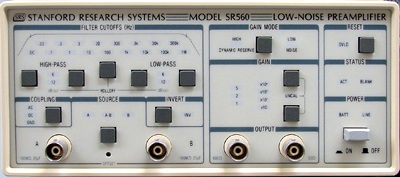
|
|
The Stanford Research SR560 Low-noise Preamplifier provides DC-coupled low-noise amplification of single ended and true differential input signals at gains of 1 to 50,000. Two configurable R-C filters are provided to selectively condition signals in the frequency range from DC to 1 MHz. The user can choose high dynamic reserve or low noise settings, and can invert the output relative to the input. The SR560 normally operates with a fully floating ground and can be viewed as an "in-line-BNC amplifier" with the amplifier ground isolated from the chassis and the AC power supply. Opto-isolated input blanking control and listen-only RS-232 interface lines are provided for instrument control. Digital noise is eliminated by shutting down the microprocessor's oscillator except during the short time required to alter the instrument's configuration, either through a front-panel pushbutton or through an RS-232 command. Internal sealed lead-acid batteries provide 15 hours of line independent operation. Rear panel banana jacks provide access to the internal regulated power supplies (or batteries) for use as a bias source. Specifications. Inputs: Single-ended or true differential. Impedance 100 MO + 25 pF, DC-coupled. Maximum Inputs: 1 VDC before overload; 3 V peak to peak max AC coupled; protected to 100 VDC. Maximum Output: 10 Vpp. Noise: <4 nV/sqrt Hz at 1 kHz. CMRR: >90 dB to 1 kHz, decreasing by 6 dB / octave (20 dB / decade) above 1 kHz. Gain: 1 to 50,000 in 1-2-5 sequence vernier gain in 0.5% steps. Frequency Response: Gains up to 1000, small signal ±0.5 dB to 1 MHz, ±0.3 dB to 300 kHz, -3 dB at 1 MHz, 1 Vpp output. Gain Stability: 200 ppm /°C. DC Drift: 5 µV/°C referred to input (DC coupled). Filters: 0.03 Hz to 1 MHz, 10% typical accuracy. Distortion: 0.01% typical.
|